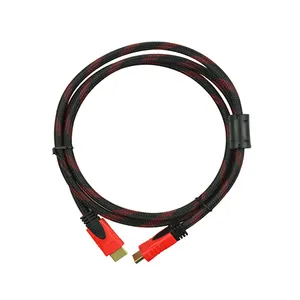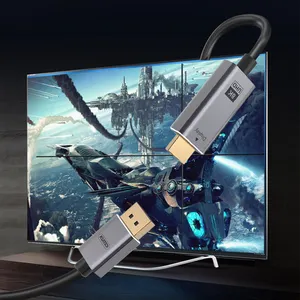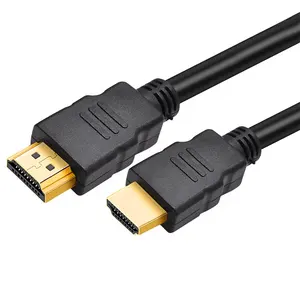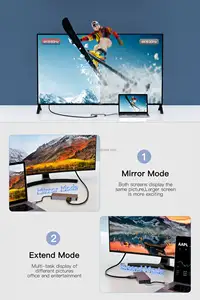Introduction
In the realm of home entertainment, the quest for superior audio-visual experiences is ceaseless. One technology that's been making waves in this domain is the HDMI over Ethernet, a game-changer for home theaters and commercial applications alike. This article delves into the intricacies of HDMI to Ethernet adapters, their necessity, benefits, and how they revolutionize the home theater experience. We also guide you on choosing the right adapter, installation, setup, and troubleshooting common issues. Prepare to transform your viewing experience like never before.
Understanding HDMI and Ethernet Adapters
HDMI over Ethernet is a technology that allows users to extend HDMI signals over long distances using Ethernet cables. It involves sending HDMI signals from a source device, such as a Blu-ray player or computer, to a display, such as a TV or projector, through an Ethernet cable. HDMI over Ethernet is becoming increasingly popular for use in home theaters, digital signage, and other commercial applications where long-distance HDMI signal transmission is required.
The Need for HDMI to Ethernet Adapters
To extend HDMI over Ethernet, you will need an HDMI over Ethernet extender. The extender consists of a transmitter and a receiver, connected to each other using an Ethernet cable. This technology is becoming increasingly popular for use in home theaters, digital signage, and other commercial applications where long-distance HDMI signal transmission is required.
Benefits of HDMI to Ethernet Adapters
HDMI over Ethernet works by encoding the HDMI signal into a data stream that can be sent over an Ethernet cable. This technology requires power to function, and the bandwidth required depends on the resolution and refresh rate of the HDMI signal. It is becoming increasingly popular for use in home theaters, digital signage, and other commercial applications where long-distance HDMI signal transmission is required.
How HDMI to Ethernet Adapters Revolutionize Home Theater Experience
By encoding the HDMI signal into a data stream, HDMI over Ethernet allows users to transmit HDMI signals up to 100 meters/328 feet or more. This AV over IP solution boasts matrix switching, video wall support, easy visual control, fast seamless switching, and other amazing features. It is ideal for wide applications like home theaters, enhancing the viewing experience.
Choosing the Right HDMI to Ethernet Adapter
When choosing the right HDMI to Ethernet adapter, consider the length you need. HDMI signal strength degrades over longer distances, so a longer cable requires a stronger receiver. Bandwidth, determined by the number of bits per second that can be transferred, is directly related to the resolution and frame rate of your image. Build quality is also important for durability and picture quality. Lastly, consider the resolution you need. If you have a 4K TV, you’ll need an HDMI 2.0 receiver for the full 4K experience. Additional features to consider include 4K support, HDR support, and HDCP 2.2 support.
Installation and Setup of HDMI to Ethernet Adapters
To install and set up HDMI over Ethernet, you'll need an HDMI over Ethernet extender, which includes a transmitter and a receiver. The transmitter connects to the source device, and the receiver to the display device. They are linked via an Ethernet cable, which can be up to 100 meters long. This setup allows HDMI signals to be transmitted over long distances. Some extenders also have built-in power over Ethernet capability, eliminating the need for a separate power supply.
Troubleshooting Common Issues
When using HDMI to Ethernet adapters, common issues may arise such as audio and video desynchronization, connection drops, and poor user experience. These problems often occur due to improper cable use or handshake issues between devices. To troubleshoot, consider the quality and length of your HDMI cable, and ensure a straight path for optimal performance. If issues persist, a full power cycle of all HDMI equipment may be necessary. For devices that don’t support HDCP, use a DVI-HDMI adapter or HDMI to DVI cable. Remember, the right Ethernet CAT cables can solve many HDMI-related problems.
Conclusion
In conclusion, HDMI to Ethernet adapters are a powerful tool in the arsenal of home theater enthusiasts and commercial users. They extend HDMI signals over long distances, enabling high-quality audio-visual experiences even in large spaces. Choosing the right adapter, proper installation, and effective troubleshooting are key to leveraging this technology. With the right HDMI over IP kit, you can enjoy features like matrix switching, video wall support, and fast seamless switching. So, gear up to revolutionize your home theater experience with HDMI to Ethernet adapters, and step into the future of immersive entertainment.












































 浙公网安备 33010002000092号
浙公网安备 33010002000092号 浙B2-20120091-4
浙B2-20120091-4